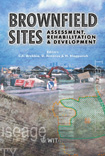Selection Of Alternative Sorbent Media For Contaminated Groundwater Clean-up
Price
Free (open access)
Transaction
Volume
55
Pages
Published
2002
Size
344 kb
Paper DOI
10.2495/BF020451
Copyright
WIT Press
Author(s)
M. R. Boni & L. D’Aprile
Abstract
Selection of alternative sorbent media for contaminated groundwater clean-up M. R. Boni & L. D’Aprile Department of Hydraulics, Transportation and Roads, University of Rome, \“La Sapienza ”, Rome, Italy Abstract Methods for the remediation of contaminated groundwater have focused, during the past years, on pump-and-treat and containment systems. Many experiences at contaminated groundwater sites and recent studies have shown the inadequacies of this approach and the need for new treatment technologies. The recent development of permeable barriers has presented a potentially viable alternative to conventional systems. Although zero-valent granular iron is the most commonly used reactive medium, a variety of media could be used to treat groundwater contaminants. This paper assesses possible alternatives to conventional sorbent media for metal removal from groundwater. The physical- chemical properties of two alternate materials (compost and expanded clay) were analysed and included particle size distribution, void ratio and dry density. Leaching test were conducted with two different methods, the first suggested by the Italian regulation on solid waste and the second, TCLP, standardized by the U.S EPA, to assess the possible drawbacks of the investigated materials in terms of release of harmful substances. Batch testing was undertaken on the investigated materials to assess their sorption potential for cadmium and nickel. The experimental results show an high removal efficiency of the investigated materials in the tested concentration range, suggesting the possibility of a successful full-scale application in a permeable barrier. Introduction At many industrial sites unappropriate plant management and uncontrolled waste disposal have led to widespread contamination of soil and groundwater. Groundwater remediation technologies usually involve extraction and subsequent treatment of contaminated water. Conventional pump-and-treat
Keywords




